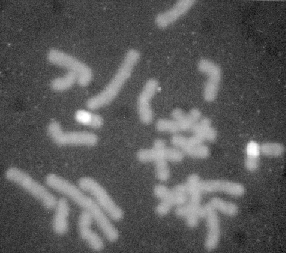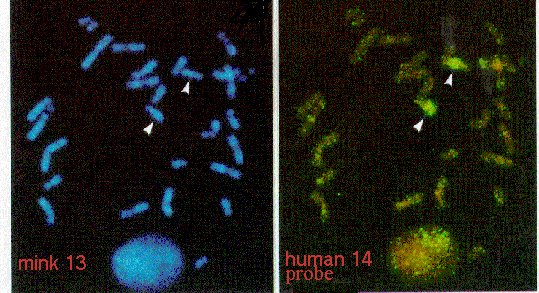Paint on swine chromosomes with a probe containing the p-arm of chromosome 12

Figure 10.7 shows paint on swine chromosomes with a DNA probe, derived from a hamster cell line which contains the p-arm of swine chromosome 12. Two chromosome arms, which are identical to the two homologue chromosomes are painted.
| Figure 10 7. Paint on swine chromosomes with a probe containing the p-arm of chromosome 12 |
 |
The paint method is summarized in the following. It is also called 'Fluorescence in situ hybridisation', FISH:
When paints with smaller pieces of DNA, for instance a 40-kb large, (inserted into a cosmid) very distinct results occur in the form of two dots, one on each of the two chromatids on the two homologous chromosomes, see here.
All human chromosomes are sorted so it is possible to buy pure DNA from every single chromosome. When each of them are labelled with different colours, the chromosome pairs also get a distinct colour of paint. This technique makes it simple to identify the chromosomes which are involved in complex translocation. Link to see paints of all human chromosomes.
By means of chromosome paint the homology between species can also be identified, see Figure 10.8 with mink chromosomes (left). The same chromosomes (right) are in situ hybridised (painted) with a human chromosome 14 probe. A table showing the homology between the chromosomes in four domestic species of animals can be seen here.
| Figure 10 8. Paint on mink chromosomes with a human chromosome 14 probe. Left are shown DAPI stained mink chromosomes. Right the identification by means of the paint which is on the p-arm of mink chromosome 13. |
 |